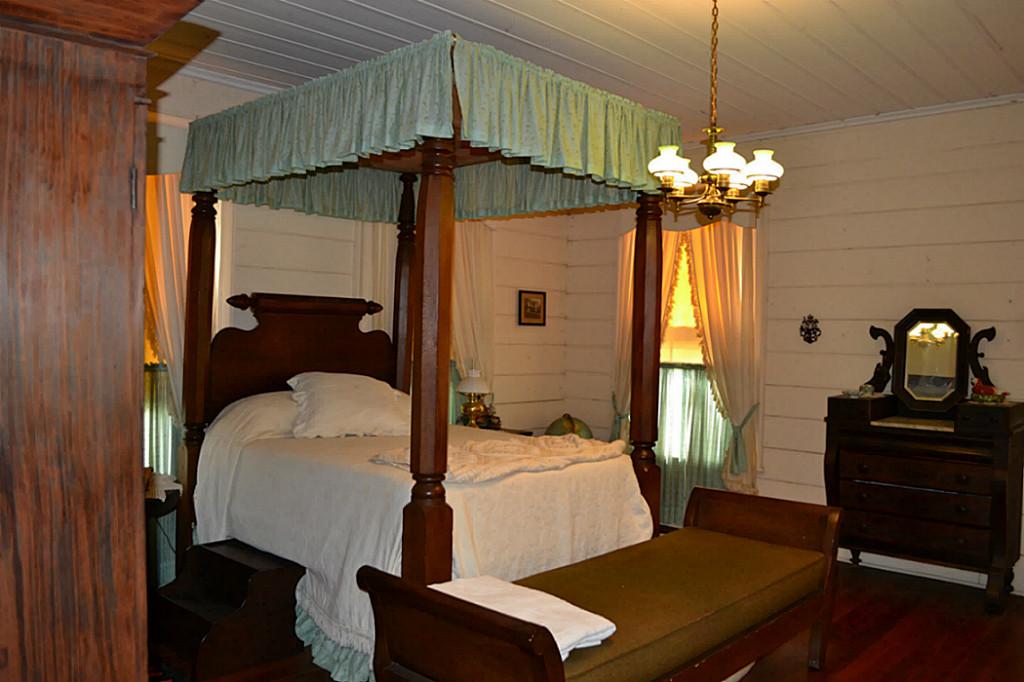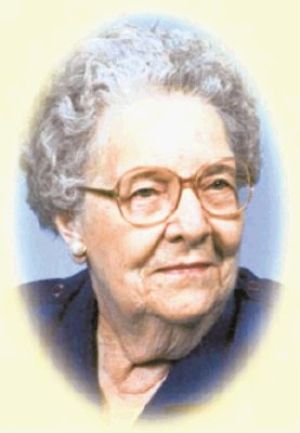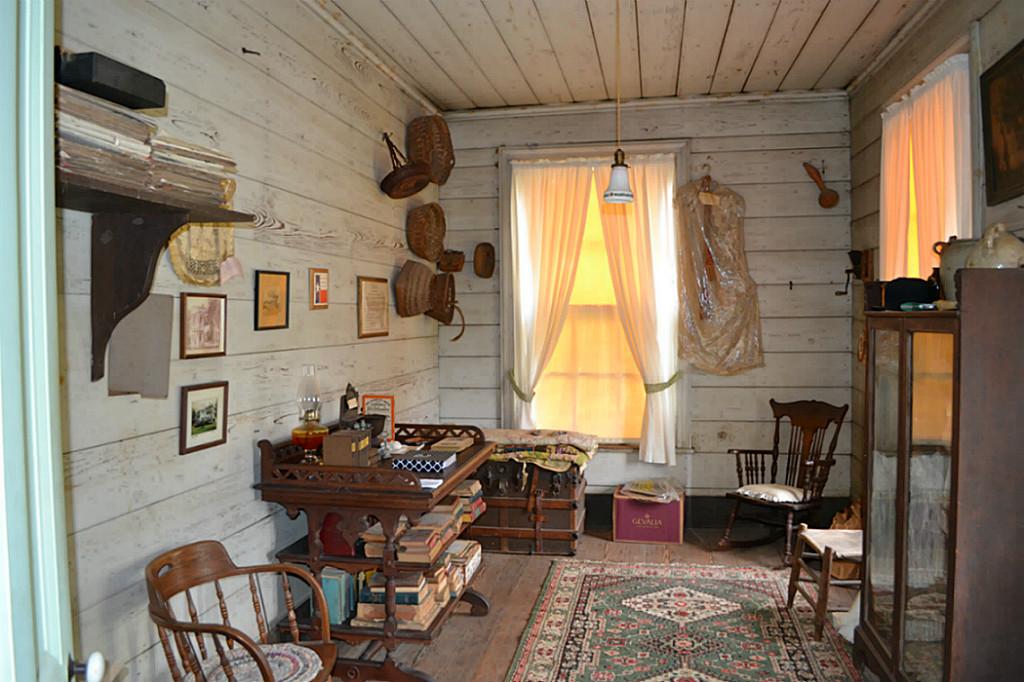One of the oldest
residences in Montgomery County offers a unique look into
the history and heritage of Texas – and for the first time
in more than a century, it’s been put up for sale.
Magnolia House was built in 1854 by Texas
entrepreneur Peter J. Willis and named for his first-born
child who was born in the house. The structure that has
survived through some of the nation’s most turbulent times
didn’t stay on the market long.

The Parlor
“There’s a contract on the home by a
couple from the United Kingdom,” said Pat Wilson Thomas, a
realtor with Elite Real Estate Professionals. “They’re very
interested in history, so this is a house that appealed to
them.”
The
2,500-square-foot, five-bedroom home is built on 1.2 acres,
located in Montgomery. The listing price was $324,000,
according to www.har.com.

One of five Bedrooms Upstairs
Peter and Richard Willis were savvy
business professionals who came to the area in 1836, before
the town of Montgomery officially existed. They became
wealthy via their mercantile store, land speculation and
other business interests.
The
brothers
were leading citizens during
the formation of the township, the county, the republic and
eventually statehood. Montgomery County originally included
Grimes, Walker and Madison counties.
In the 1850s, Montgomery County had one of
the largest slave-holding populations in the state, with
more than 1,500 slaves, valued at more than $750,000, who
worked on plantations growing the major cash crop of the day
– cotton, according to Larry Foerster, chairman of the
Montgomery County Historical Society.
“Cotton was the dominant crop in western
Montgomery County,” said Foerster. “The average land value
was $2.30 per acre, with premium land going for $4-10 per
acre.”
With his success, Peter Willis employed
John Shelton, a prominent builder, to construct his
showplace home in Montgomery.
“Sam Houston was a regular visitor and
lodger in the home,” said Thomas. “Montgomery was the
original county seat, so he was here on a regular basis.”
The Willis brothers were also
contemporaries of Charles B. Stewart, designer of the Lone
Star flag and another resident of Montgomery.
By 1860, the slave population swelled to
more than 2,106, valued at $1.3 million – but the coming
Civil War that would free the slaves would devastate the
wealth and growth of Montgomery.
While much of Montgomery opposed the Civil
War, most of the men and much of the material wealth of the
area went into the war effort. Company H of the Fourth Texas
Regiment lost half of its men – mostly from Montgomery – at
Gettysburg. By the end of the Civil War, only nine of the
original 145 members of Company H were survived without
being killed or severely wounded.
The conflict also motivated the Willis
brothers to pack up and move to Galveston, where their
economic success continued. Land they donated to the
community from their vast holdings would later become known
as Willis in their honor.
“Magnolia Oil Company was named after
Willis’ daughter born in Montgomery,” said Foerster. It
later became known as Mobil Oil, which eventually merged
with Exxon.”
The Montgomery area declined financially
after the war. Cotton was replaced with cattle ranches and
less successful agricultural enterprises. The large
plantations were divided and re-divided to form many of the
subdivisions and estates that now exist in Montgomery
County.
After the war, the Davis family purchased
the Magnolia House, said Thomas. It stayed in the family
since they acquired it around the time of the Civil War.
“It’s been in the family since 1866,” said
Thomas. “Much of the building is original and many of the
artifacts and furnishing date back a long time. It’s a
charming, historical building.”
Although the Willis family had relocated
to Galveston, their impact on the area continued to be
important. Wealthy businessman George Sealy – who married
Magnolia Willis – is a key investor in the Central and
Montgomery Railroad, running between Navasota and
Montgomery. The railroad would eventually expand to Conroe
in 1885 with a fast train known as “The Flyer,” with twice
daily service.
 Anna
Landrum Davis Weisinger, “Aunt Anna,” as she was
affectionately known to Montgomery locals, lived in the
Magnolia home until her death in 2005 at the age of 97.
Anna
Landrum Davis Weisinger, “Aunt Anna,” as she was
affectionately known to Montgomery locals, lived in the
Magnolia home until her death in 2005 at the age of 97.
Weisinger was born in the home and she
later married Raymond Weisinger and spent many years
updating the historic home.
According to Montgomery historian Sonya
Clover, the home was in pretty bad shape when Weisinger and
her husband took it over the 50s. Clover said they’d take
out a loan and fix one part, then take out another loan and
fix another part.

Over her lifetime, Anna Davis
Weisinger made many improvements to the home. She
lived there most of her life until her death at age
97 in 2005.
Eventually the home was restored to its
grandeur and was the first to boast a historic medallion in
Montgomery.
Many of the original furnishing remain in
the home, having come up from Galveston on a wagon.
She was also a noted historian for the
Montgomery area and loved to share stories about the town’s
early history.
“If you wanted to know something about
Montgomery, you went to Miss Anna or Bessie Owen or Cissy
Boulware,” Clover said. “I sat around her (Weisinger’s)
kitchen table many times as she told her stories.”
The last relative of the Davis family to
live in Magnolia was Betty McKenzie, Anna Davis Weisinger’s
niece. McKenzie passed away in February 2012 and following
her death, the home was put up for sale.
“There is so much history in Montgomery
County,” said Foerster. “It’s nice to see something from the
past continue to be source of pride and perspective in the
community.”
For information on
Conroe and Montgomery County history, visit www.heritagemuseum.us or
call 936-539-6873.
A glimpse into Montgomery’s history
Anna Davis Weisinger, who was a long-time resident of
Montgomery, shared many stories with others. These stories
give little glimpses into the early years of the city. Anna
lived with her Aunt whom she called “Auntie.” “Auntie had a
telephone when I lived with her. It was a crank telephone
mounted on the wall. I can remember her having it as early
as 1917. The telephone office was upstairs in one of those
two-story buildings that burned in 1920, the night the whole
town burnt. Auntie let me walk all the way to the Richard
Willis house, where the Berkley’s lived at that time, then
she called me on the telephone and told me to come home and
do my chores. When I was a kid growing up, we had a great
big metal cistern that sat on the ground outside next to the
kitchen. It must have caught water from the roof, but I
don’t remember. We used to play school out there. We would
write on the outside of the cistern, using it as a
blackboard. I’m sure if we drank that water, Auntie must
have boiled it. The old water tank northwest of the corner
of College and FM 149 was built with a wooden tank in the
early 20’s, but I don’t know if we got water from it or
not.”
The following passage with quotes from
Anna Davis Weisinger was first printed as a Social Lite
column by Sonya Clover in September 2012.

Vote Montgomery County TXGenWeb County of the Month



 Anna
Landrum Davis Weisinger, “Aunt Anna,” as she was
affectionately known to Montgomery locals, lived in the
Magnolia home until her death in 2005 at the age of 97.
Anna
Landrum Davis Weisinger, “Aunt Anna,” as she was
affectionately known to Montgomery locals, lived in the
Magnolia home until her death in 2005 at the age of 97.